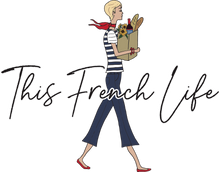I LOVED all of your fun feedback about moules in France, and I even convinced some of you to try them the next time you’re here! Wahoo!
Here are a couple more scenes from the Bay of Saint-Brieuc and fun facts about mussels from Bretagne.
Scene 1: This crazy-looking ship-truck-fishing boat is what they drive out onto the flats during low tide to tend to the mussels. If the mariée starts to come in, the truck simply starts to float, and they can motor back to dry land and drive off!
Scene 2: This beach is particularly popular with horse and buggy drivers who love to race up and down the flats.
Scene 3: This part of the coastline is called the Cotes Emeraude, or Emerald Coast, for its beautiful blue-green waters.
Mussel (moules) growers carry out the natural capture of mussel larvae on natural and biodegradable fiber ropes. They are then rolled up around wooden stakes, called “bouchots,” which is also the name of the moules. The mussels are out of the reach of crabs and other predators. Each bouchot can carry up to 80 kg of mussels. The shell of bouchot mussels is at least 12 mm thick and does not exceed 8 cm in length. It does not contain sand or parasites.
Bouchot mussels from the bay of Mont Saint-Michel are the only Protected Designation of Origin (PDO) for seafood products obtained since 2011. Production spreads over 248 kilometers in the bay of Mont-Saint-Michel and is tended by around forty mussel farmers. These mussels are designated by the AOP logo and their sanitary label.
How were the bouchot mussels born? Stories have it that the Irishman Patrick Walton, in 1235, noticed that stakes planted in the sea were spontaneously covered with mussels. The stakes joined together with the help of hurdles then form a wooden fence, which he calls “bout” and “choat”. The bouchots take their name from this invention.
Bisous and big hugs from Bretagne,
Shannon

